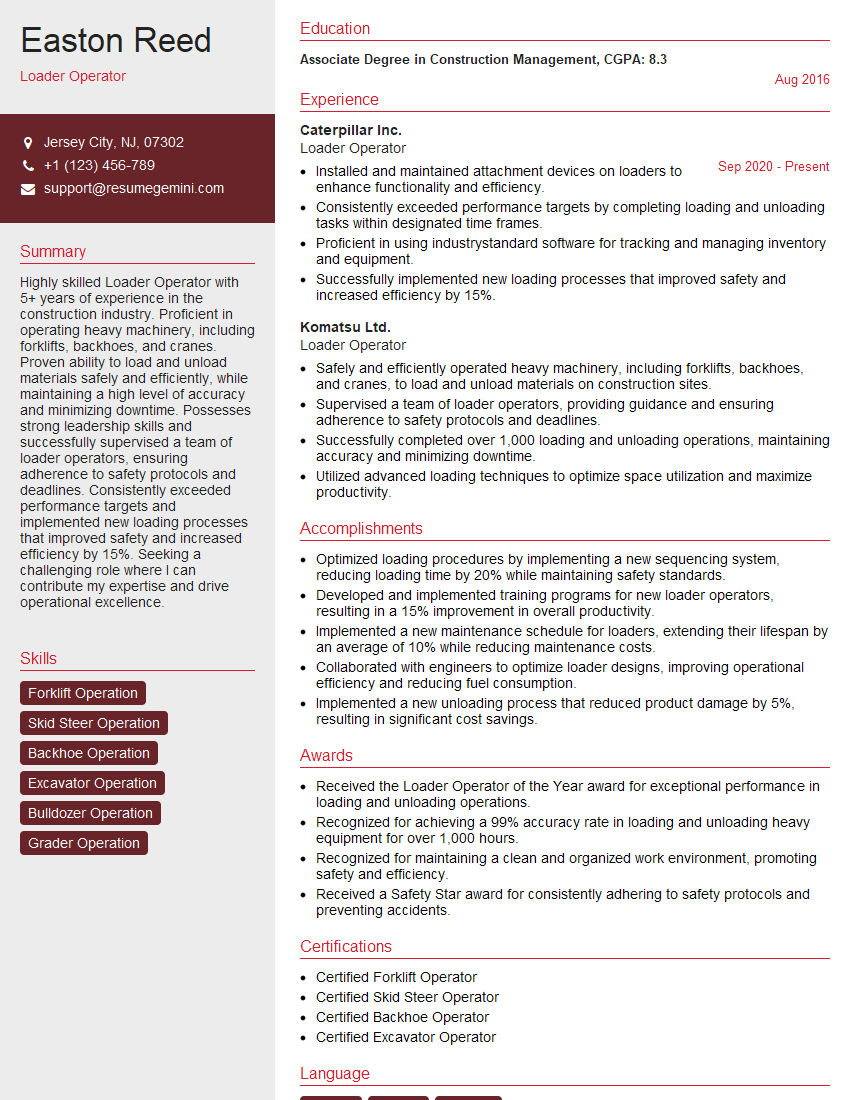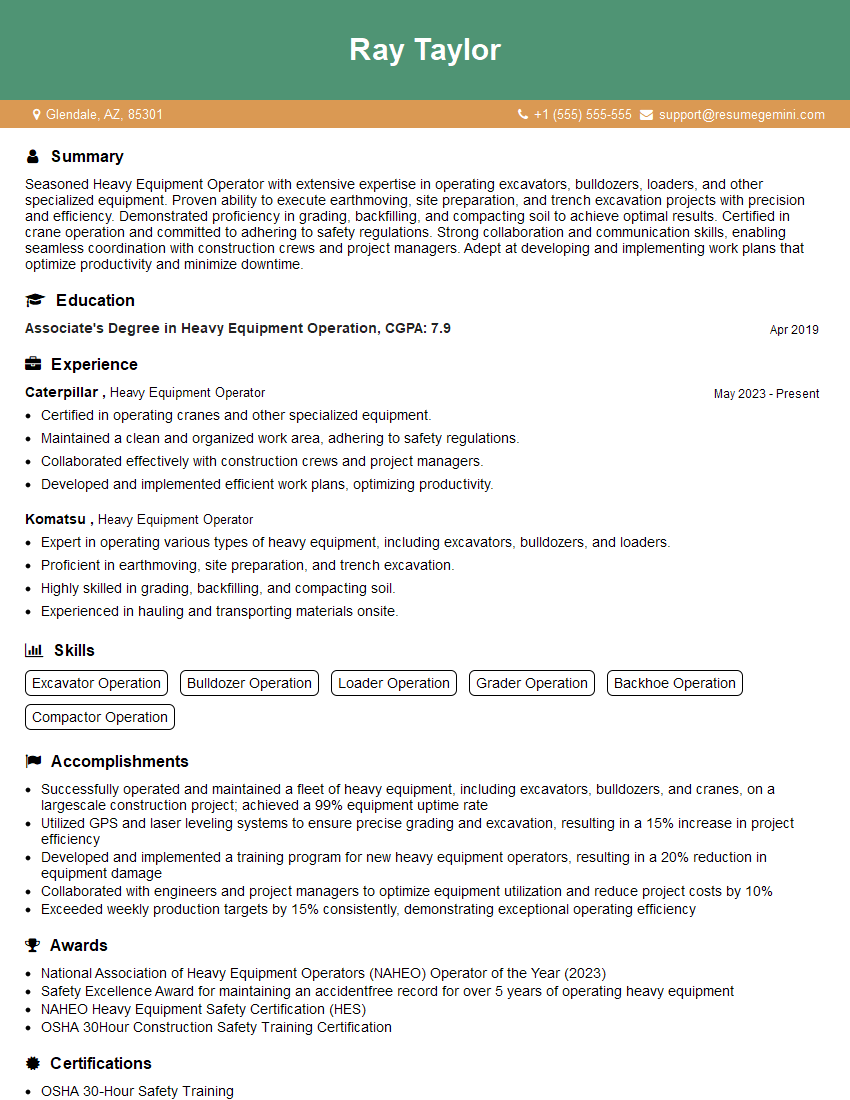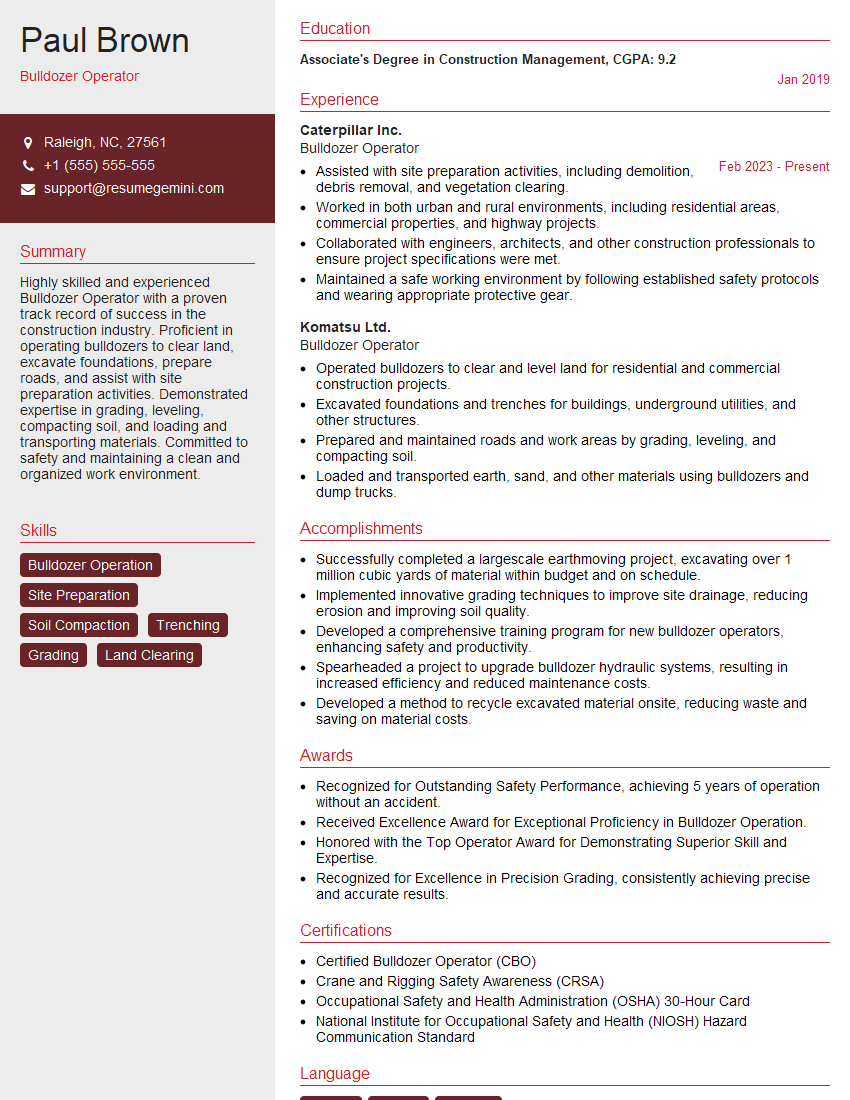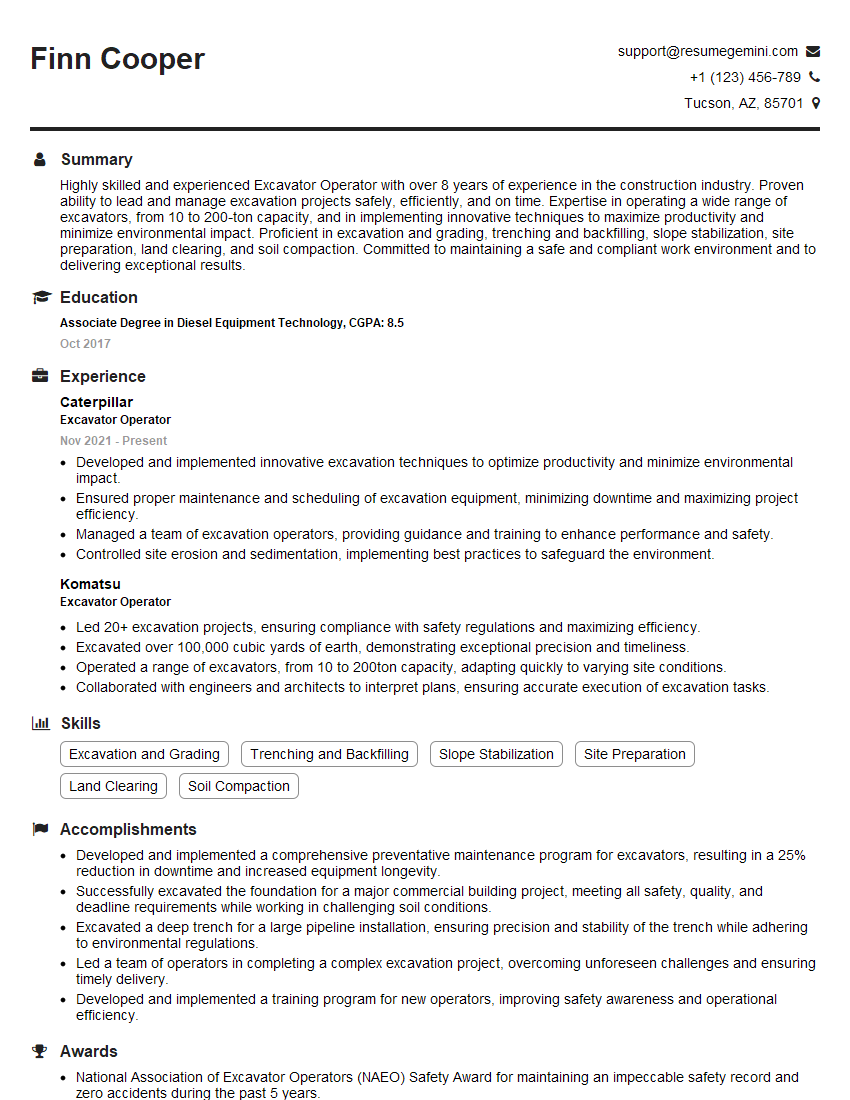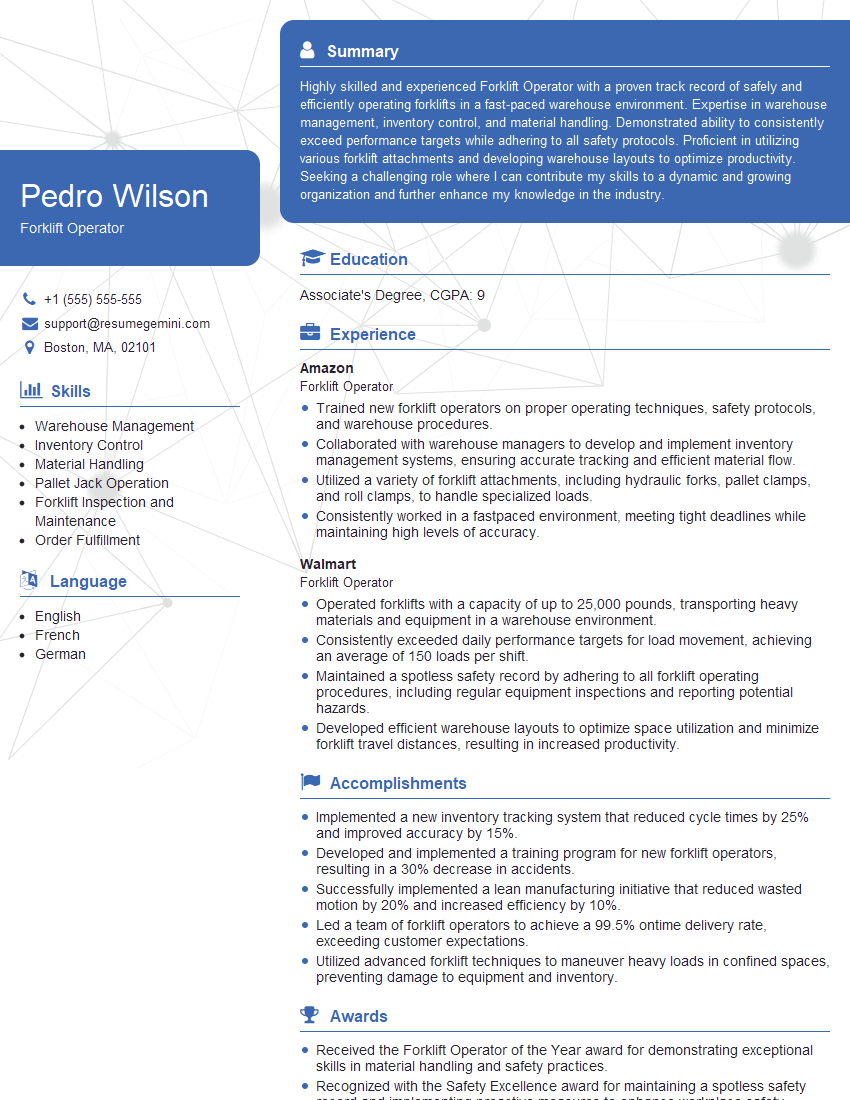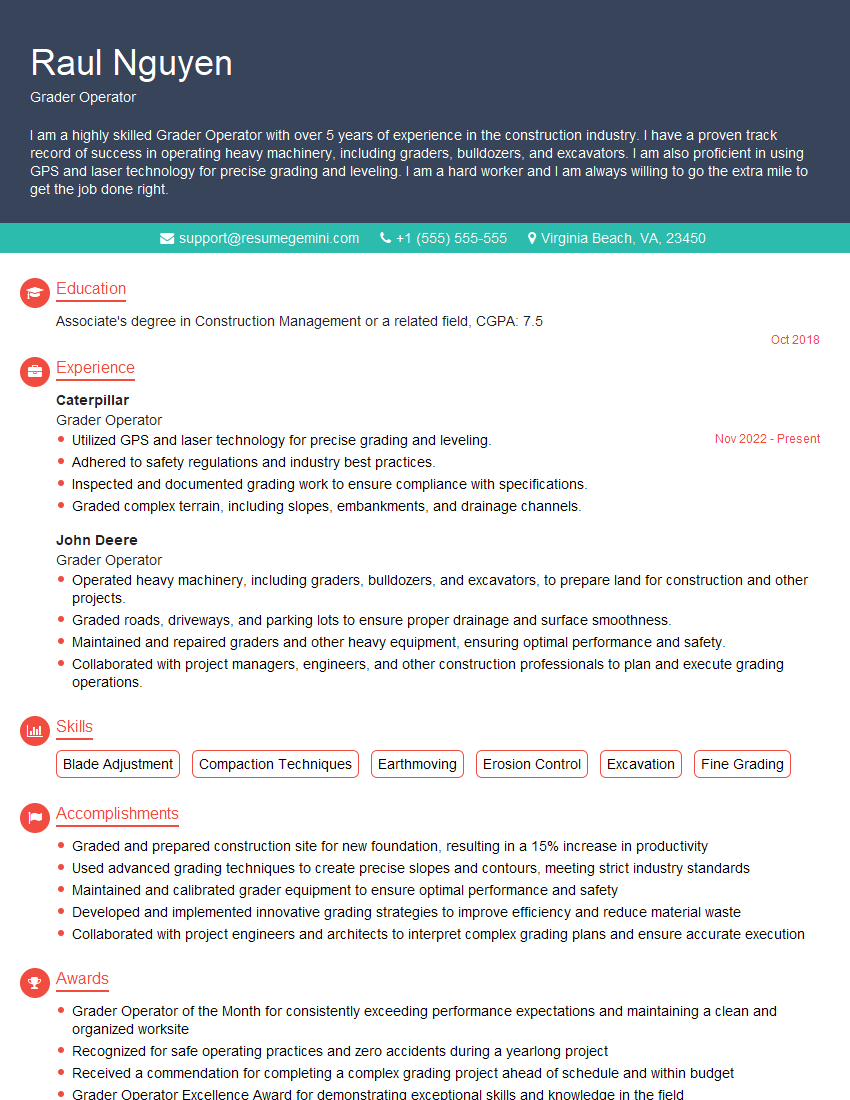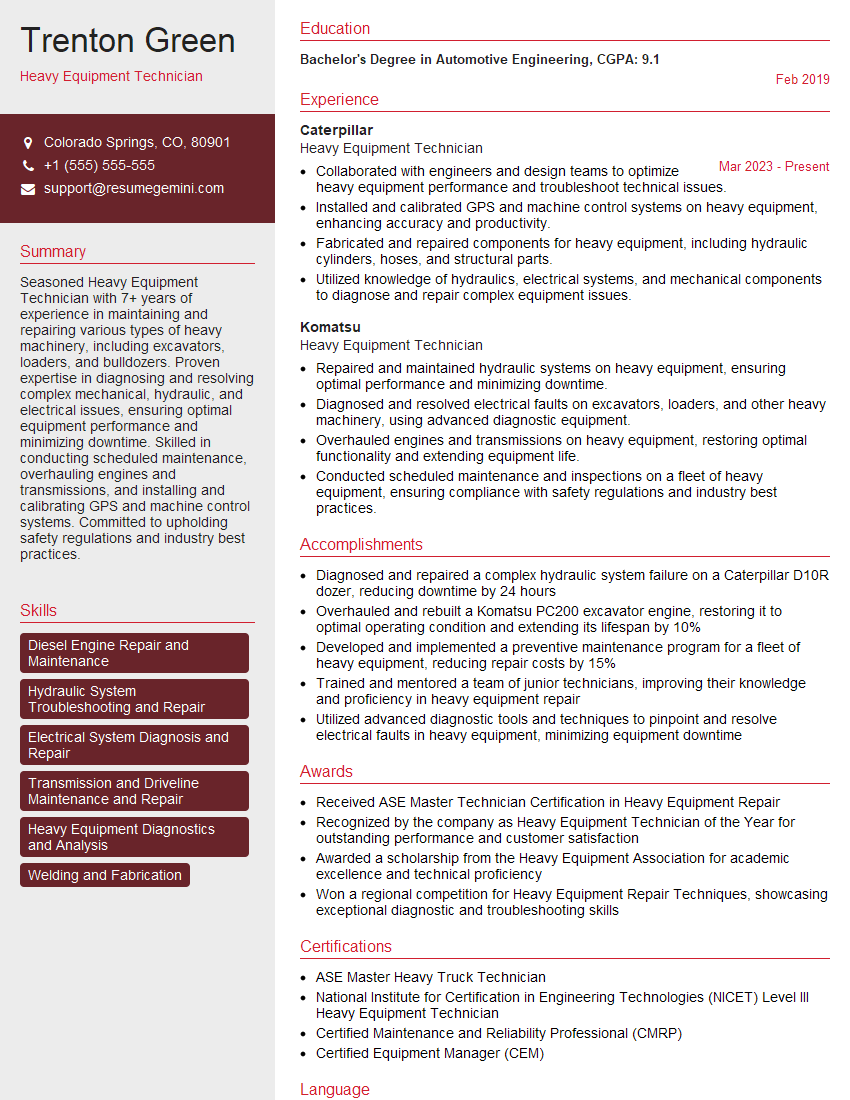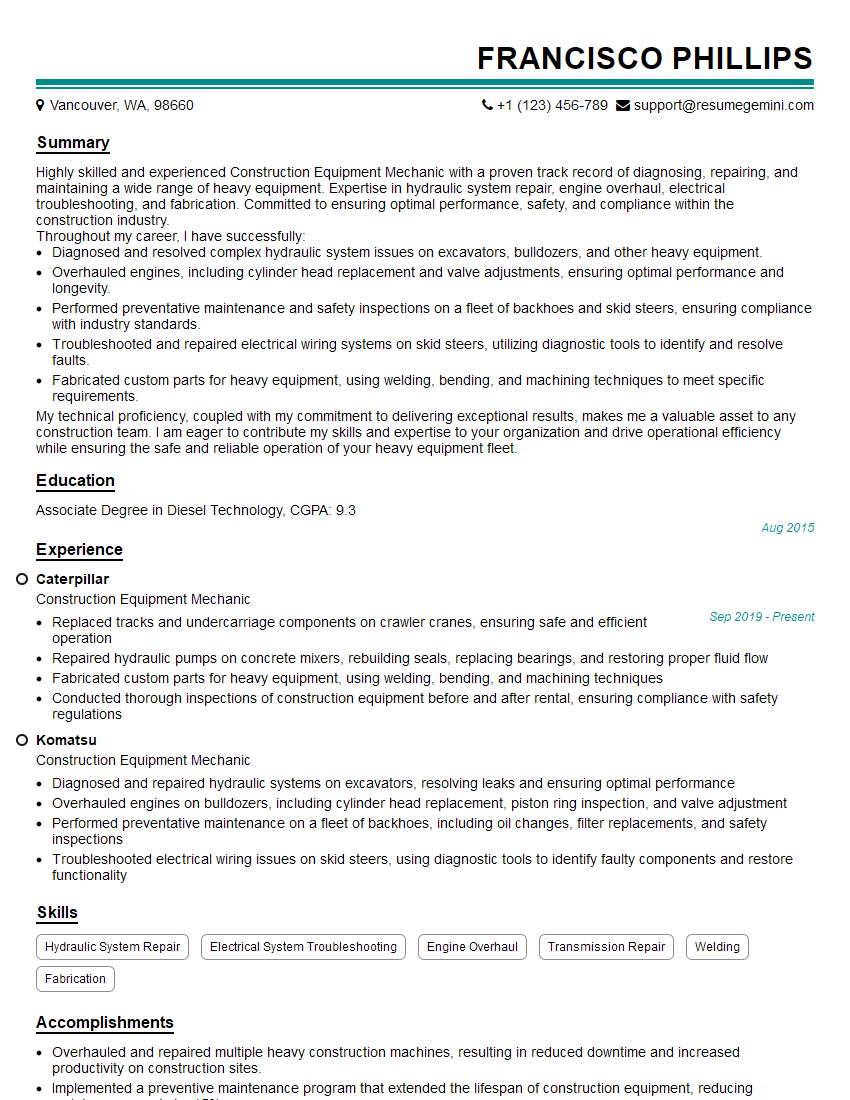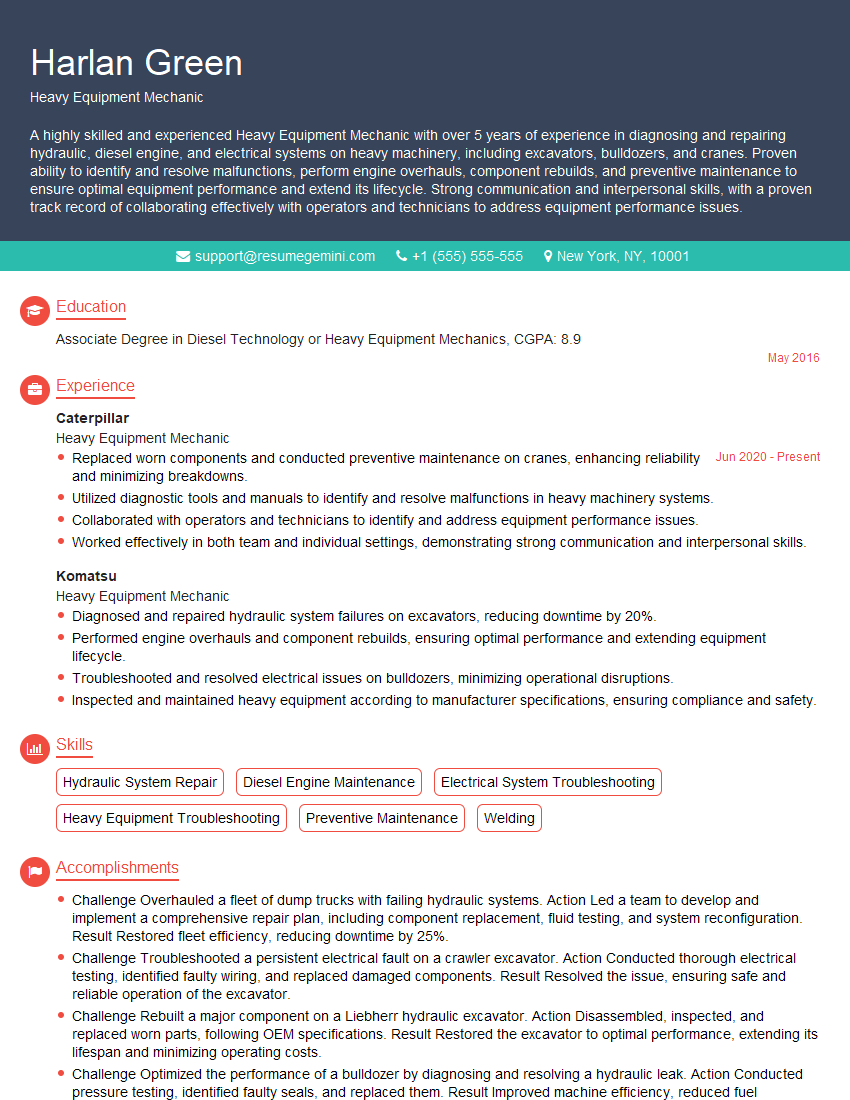Feeling uncertain about what to expect in your upcoming interview? We’ve got you covered! This blog highlights the most important ExperienceWithHeavyEquipment interview questions and provides actionable advice to help you stand out as the ideal candidate. Let’s pave the way for your success.
Questions Asked in ExperienceWithHeavyEquipment Interview
Q 1. Describe your experience operating excavators.
My experience operating excavators spans over ten years, encompassing a wide range of projects, from small-scale residential developments to large-scale infrastructure projects. I’m proficient in operating various excavator models, including both crawler and wheeled types, and have experience with different attachments like buckets, breakers, and grapples. I’m comfortable working in diverse terrains and conditions, adapting my techniques to maximize efficiency and safety. For example, on one project involving a tight urban site, I successfully utilized a compact excavator to efficiently excavate foundations without compromising safety or causing disruption to the surrounding area. Another project involved using a larger excavator with a specialized grapple attachment to handle and place large concrete blocks for a retaining wall, highlighting my adaptability to different project demands.
Q 2. Explain the different types of bulldozers and their applications.
Bulldozers are categorized primarily by their blade type and drive system. The most common blade types are straight, angle, and U-blades. A straight blade is best for moving large volumes of material in a straight line. An angle blade offers more versatility, allowing for side casting and more precise earthmoving. A U-blade is ideal for fine grading and finishing work. Regarding drive systems, crawler bulldozers offer superior traction and stability on uneven terrain, making them ideal for tough jobsites. Wheel bulldozers, on the other hand, provide greater speed and maneuverability on flatter, more stable ground, making them efficient for large-scale projects requiring quicker material movement.
Applications vary greatly depending on the type: Straight blades are commonly used in large-scale land clearing or earthmoving, angle blades are frequently used in road construction or site preparation, and U-blades are crucial for final grading and landscaping. Crawler bulldozers are prevalent in mining, forestry, and heavy construction, while wheeled bulldozers are often seen in large-scale road building and land development projects.
Q 3. What safety procedures do you follow when operating heavy equipment?
Safety is paramount in heavy equipment operation. My safety procedures always begin with a thorough pre-operational check (discussed in the next answer). Beyond that, I adhere strictly to site-specific safety regulations, always wearing appropriate personal protective equipment (PPE), including hard hats, safety glasses, gloves, and high-visibility clothing. I maintain a safe distance from other equipment and personnel, and I’m always aware of my surroundings, including overhead power lines and potential hazards. I never operate equipment if I’m fatigued or under the influence of drugs or alcohol. Blind spots are a significant concern, so I rely on spotters when necessary, especially in confined spaces. Before starting any maneuver, I visually assess the area and communicate my intentions clearly to those around me. Regular training and refresher courses keep my safety practices updated and sharp.
Q 4. How do you perform pre-operational checks on heavy machinery?
Pre-operational checks are a non-negotiable part of my routine. It’s a systematic process ensuring the machine is in safe working order. It typically involves:
- Visual inspection: Checking for any visible damage to the machine, tires, and attachments.
- Fluid levels: Verifying engine oil, hydraulic fluid, coolant, and fuel levels are within acceptable ranges.
- Tire pressure: Ensuring proper tire inflation for optimal performance and safety.
- Lights and signals: Confirming all lights, horns, and warning signals are functioning correctly.
- Operational systems: Testing all controls, including steering, brakes, and attachments, to ensure smooth and responsive operation.
- Safety systems: Checking the functionality of safety devices like seatbelts, emergency stops, and warning alarms.
Ignoring this process is not an option; it’s crucial for preventing accidents and costly repairs.
Q 5. Describe your experience with preventative maintenance on heavy equipment.
Preventative maintenance is key to extending the lifespan of heavy equipment and preventing costly breakdowns. My experience includes performing regular lubrication, cleaning, and inspecting components according to the manufacturer’s recommendations. I meticulously track service intervals and document all maintenance activities. This includes changing filters, lubricating joints, and inspecting wear parts like tracks, tires, and hydraulic hoses. I’ve also assisted with more complex maintenance procedures, such as replacing worn components and performing minor repairs. Proactive maintenance not only reduces downtime but also contributes significantly to safety by preventing unexpected failures during operation. For instance, regularly checking hydraulic lines for leaks prevented a significant hydraulic failure on a recent project, saving both time and money.
Q 6. What are the common causes of heavy equipment malfunctions?
Heavy equipment malfunctions stem from various sources, often intertwined. Common causes include:
- Lack of preventative maintenance: Neglecting regular service leads to component wear and tear, eventually resulting in failures.
- Operator error: Incorrect operation or overloading can stress components beyond their design limits.
- Hydraulic system issues: Leaks, worn seals, or contaminated fluid can significantly impact performance and cause malfunctions.
- Engine problems: Issues with fuel delivery, ignition, or cooling systems can lead to engine failure or reduced performance.
- Electrical faults: Wiring problems, faulty sensors, or damaged components can disrupt various systems.
- Wear and tear: Normal wear and tear on components, especially in harsh operating environments, can ultimately lead to failure.
Proper maintenance and operator training can significantly mitigate many of these issues.
Q 7. How do you troubleshoot hydraulic system problems in heavy equipment?
Troubleshooting hydraulic system problems requires a systematic approach. I begin with a thorough visual inspection, looking for leaks, loose connections, or damaged components. I’ll then check fluid levels and condition, looking for contamination or discoloration. If a leak is detected, I would isolate the source to pinpoint the faulty component, which could range from a simple hose clamp to a more complex component like a hydraulic pump or valve. I might utilize diagnostic tools, like pressure gauges, to measure hydraulic pressure and identify any anomalies. If the problem is electrical, I might utilize multimeters to check for voltage and current to identify any faulty wiring or electrical components. More complex issues often require specialized tools and potentially the assistance of a mechanic. However, my experience allows me to quickly assess the situation and determine the best course of action, whether it’s a simple repair or calling in a specialist.
Q 8. Explain your experience with different types of crane operations.
My experience encompasses a wide range of crane operations, including tower cranes, mobile cranes, and overhead cranes. I’m proficient in various lifting techniques, such as picking and placing loads, and understand the critical importance of load charts and safe working limits. For example, while working on a high-rise construction project, I successfully used a tower crane to lift pre-fabricated sections weighing up to 15 tons, carefully adhering to the crane’s load chart and coordinating with the ground crew for precise placement. With mobile cranes, I have experience in various terrains, ensuring stability and safety even on uneven ground. My experience with overhead cranes focuses on efficient and safe material handling in factory and warehouse settings, minimizing downtime and ensuring a smooth workflow.
I’ve also been extensively trained on different types of crane rigging, including selecting the appropriate slings and ensuring proper hitching to prevent load sway and accidents. The safety of the load and those working around the crane are always my top priorities.
Q 9. Describe your experience with load capacity calculations.
Load capacity calculations are crucial for safe crane operations. I use a combination of mathematical formulas, load charts provided by the manufacturer, and my understanding of factors like wind speed, crane type, and sling angles to calculate the safe working load. I always start by identifying the weight of the load itself, accounting for any additional weight from rigging equipment (slings, shackles, etc.). Then, I carefully consider the crane’s specific load chart, which provides safe lifting capacities based on the crane’s configuration (e.g., boom length, radius). It’s essential to account for the reduction in lifting capacity with increased boom length and radius.
For instance, if I’m lifting a load with a mobile crane, I’d use the crane’s load chart to find the maximum safe weight I can lift at a specific boom length and radius. I’d never exceed the limits in any circumstance. I also make sure to take environmental factors into account. High wind speeds drastically reduce a crane’s lifting capacity, so adjustments are vital. I always double-check my calculations, and if there is any doubt, I consult with a supervisor before proceeding.
Q 10. How do you ensure the safe operation of heavy equipment in confined spaces?
Operating heavy equipment in confined spaces demands heightened awareness and meticulous planning. The key is thorough risk assessment and mitigation. I start by carefully analyzing the site, identifying potential hazards such as overhead obstructions, nearby structures, and power lines. Understanding the exact dimensions of both the equipment and the workspace is paramount. This means calculating swing radii, clearances, and maneuverability paths in advance. Proper communication with the ground crew and other personnel is essential to prevent accidents. I always use spotters to assist and warn others of any potential hazards during operation. Before starting work, I take time to map out a safe and efficient operating strategy. This includes selecting the right equipment for the task, taking into account the size and maneuverability constraints of the space.
For example, when working in a tight urban environment, I would prefer a smaller, more maneuverable machine over a larger one even if the larger one might have a higher capacity. Safety always takes precedence over efficiency.
Q 11. What are the different types of loaders and their applications?
Loaders are versatile machines used for material handling in various industries. The most common types include wheel loaders and skid steer loaders. Wheel loaders are larger and have more lifting capacity, ideal for moving large volumes of material like dirt, gravel, or snow over longer distances. They are commonly found in construction and mining. Skid steer loaders, on the other hand, are smaller, more compact machines with excellent maneuverability, perfect for confined spaces and precise tasks. They are very common in landscaping, construction, and agriculture.
Other types include backhoe loaders, which combine a front-end loader with a backhoe, offering versatility for digging and loading; and telescopic handlers (telehandlers), which have a telescoping boom allowing them to lift materials to significant heights, frequently used in warehousing and construction.
- Wheel Loaders: Construction, mining, snow removal
- Skid Steer Loaders: Landscaping, agriculture, construction in tight spaces
- Backhoe Loaders: Digging trenches, loading materials, site preparation
- Telehandlers: Warehousing, construction (high-reach applications)
Q 12. How do you handle unexpected equipment failures during operation?
Unexpected equipment failures can be dangerous and require immediate, calm, and decisive action. My first response is to always prioritize safety. I immediately shut down the equipment and assess the situation, determining the nature of the failure and the potential risks. If the problem is minor and can be safely addressed on-site, I may attempt to perform basic troubleshooting. However, if the issue seems serious or potentially dangerous, I would immediately report it to my supervisor and follow the established procedures for equipment failure. This usually involves securing the area, informing relevant personnel, and waiting for qualified technicians to assess and repair the equipment.
For instance, if a hydraulic line bursts, I would immediately stop the machine, engage the parking brake, and carefully exit the vehicle before alerting the team about the leak. I would never attempt to repair the damage myself without proper training and safety precautions.
Q 13. Describe your experience working with GPS-guided equipment.
I have significant experience operating GPS-guided equipment, specifically in earthmoving and grading applications. This technology significantly enhances precision and efficiency, reducing material waste and improving the overall quality of work. The GPS system provides real-time positioning data, guiding the operator to follow pre-planned paths and grades, ensuring accuracy within millimeters. This is particularly beneficial in large-scale projects requiring precise earthwork.
For example, in a road construction project, I used a GPS-guided grader to accurately shape the roadbed according to the design specifications. The system guided my movements, ensuring the correct slope and elevation were achieved with minimal human intervention, significantly increasing efficiency and reducing the need for manual adjustments.
Q 14. How do you maintain accurate records of equipment operation and maintenance?
Maintaining accurate records is essential for compliance and equipment management. I utilize both digital and physical methods. For digital records, I use specialized software that tracks operating hours, fuel consumption, maintenance schedules, and any repairs or issues that arise. This data provides valuable insights into equipment performance and helps predict future maintenance needs. I’m also responsible for completing detailed pre- and post-operation checklists and recording any relevant observations. This data is crucial for identifying potential problems early on and preventing costly breakdowns.
In addition to digital records, I maintain a physical logbook where I manually record daily operational data, including work performed, any unusual occurrences, and even weather conditions. This redundancy ensures data backup and provides additional layers of documentation. Regularly reviewing these records allows for more efficient scheduling of maintenance, reducing downtime and maximizing equipment lifespan.
Q 15. What is your experience with different types of ground conditions and their impact on equipment operation?
Ground conditions significantly impact heavy equipment operation. Different soil types – from soft clay to solid rock – require varying techniques and potentially different equipment. For example, operating a bulldozer on loose sand necessitates a slower, more deliberate approach to avoid sinking or losing traction. Conversely, excavating in hard rock requires specialized attachments like rock breakers and may call for more powerful machines. My experience encompasses working across a wide range of conditions including:
- Soft Soils: I’ve managed projects involving swampy land and loose alluvial deposits, requiring careful planning of routes and potentially the use of mats or temporary roadways to distribute the weight of the equipment and prevent ground settlement. This often involves constant monitoring of ground conditions to adjust operations as needed.
- Hard Soils: I’ve worked extensively on rocky terrain, needing to adjust machine settings and select appropriate attachments (rippers, rock breakers) for efficient excavation and removal. Understanding the rock’s composition (e.g., shale vs. granite) is crucial for optimizing both productivity and machine longevity.
- Mixed Soils: Often, sites contain a mix of soil types. I’ve learned to identify these changes quickly and adapt my technique to avoid unexpected challenges such as equipment becoming stuck or damaging underlying infrastructure.
Understanding these variations is critical for ensuring both project success and equipment safety. It involves anticipating potential issues and proactively adjusting operational strategies.
Career Expert Tips:
- Ace those interviews! Prepare effectively by reviewing the Top 50 Most Common Interview Questions on ResumeGemini.
- Navigate your job search with confidence! Explore a wide range of Career Tips on ResumeGemini. Learn about common challenges and recommendations to overcome them.
- Craft the perfect resume! Master the Art of Resume Writing with ResumeGemini’s guide. Showcase your unique qualifications and achievements effectively.
- Don’t miss out on holiday savings! Build your dream resume with ResumeGemini’s ATS optimized templates.
Q 16. Describe your experience with operating equipment in challenging weather conditions.
Operating heavy equipment in challenging weather presents significant safety and operational considerations. My experience includes working in extreme heat, heavy rain, snow, and high winds. For instance, operating an excavator in heavy rain requires extra caution to maintain visibility and control, as well as awareness of the potential for mud and slippery surfaces. I always prioritize safety by:
- Visibility: Using appropriate lighting, even during daylight hours in poor visibility conditions. Keeping windows and mirrors clear is essential.
- Traction: Adjusting equipment settings (e.g., tire pressure, differential lock) and selecting appropriate operating speeds to maintain control on slick or icy surfaces.
- Stability: Being especially mindful of load stability in windy conditions and reducing operating speed significantly. High winds can affect the stability of both the machine and the load.
- Extreme Temperatures: Taking regular breaks to avoid heat exhaustion or hypothermia, utilizing climate control systems in the machine, and ensuring appropriate personal protective equipment (PPE) is worn.
Weather-related delays are often unavoidable. However, through careful planning and proactive safety measures, I can minimize disruption and complete projects safely and efficiently.
Q 17. Explain your understanding of load stability and its importance.
Load stability is paramount when operating heavy equipment. It refers to the safe and balanced distribution of weight to prevent tipping or other accidents. This involves considering the center of gravity of both the machine and the load, as well as the ground conditions. An unbalanced load dramatically increases the risk of machine rollover, which can have catastrophic consequences. My experience emphasizes the importance of:
- Proper Load Securing: Using appropriate straps, chains, or other securing devices to prevent shifting during transport or operation.
- Center of Gravity: Understanding and calculating the combined center of gravity of the machine and its load is key. I have used load charts and specialized software to analyze load stability in complex scenarios.
- Terrain Assessment: Evaluating the stability of the ground before lifting or moving heavy loads. Avoiding operating on unstable surfaces, slopes, or near excavations is vital.
- Safe Lifting Practices: Gradually lifting and lowering loads, avoiding abrupt movements, and keeping the load within the machine’s safe working limits.
Ignoring load stability can lead to accidents. I always prioritize a thorough assessment and employ cautious operation to ensure safe handling of materials.
Q 18. How do you communicate effectively with other members of a construction crew?
Effective communication is the cornerstone of safety and productivity on any construction site. I utilize various methods to communicate clearly and efficiently with my crew:
- Pre-Job Briefings: Participating actively in safety meetings to ensure that everyone is aware of the day’s tasks, potential hazards, and safe operating procedures.
- Clear and Concise Language: Using plain language to avoid misinterpretations. Hand signals are also employed where verbal communication might be difficult due to noise levels.
- Two-Way Communication: Actively listening and responding to questions and concerns raised by crew members, fostering a culture of open communication.
- Visual Aids: Using diagrams or plans to clarify complex tasks or instructions.
- Radio Communication: Employing two-way radios to communicate quickly and efficiently across the jobsite.
Open and respectful communication is vital to a safe and productive work environment. I believe in creating a team atmosphere where everyone feels comfortable expressing concerns and contributing to a safe and efficient workflow.
Q 19. Describe your experience with working at heights using heavy equipment.
Working at heights with heavy equipment demands meticulous planning and adherence to strict safety protocols. My experience includes operating equipment on elevated platforms and slopes. Key aspects I focus on include:
- Equipment Stability: Ensuring the equipment is correctly positioned and stabilized before commencing operations. This includes using outriggers and levelers where necessary.
- Safe Access and Egress: Using designated access points and ensuring that all safety measures such as handrails and fall protection are in place.
- Load Handling: Extra caution is taken when handling loads at height, as the risk of tipping or dropping the load is significantly increased.
- Environmental Factors: Considering wind speed and direction, as well as precipitation and visibility, and adjusting operations as needed.
- Regular Inspections: Equipment and safety devices are regularly inspected to ensure they are in good working order.
Working at heights requires a heightened sense of awareness and strict adherence to safety regulations. Any compromise in safety procedures can have dire consequences. My approach is always proactive and risk-averse, prioritizing safety above all else.
Q 20. Explain your knowledge of relevant safety regulations and standards.
My understanding of safety regulations and standards is comprehensive and continually updated. I am familiar with OSHA regulations (or equivalent in relevant jurisdictions), including those pertaining to heavy equipment operation, fall protection, confined spaces, and lockout/tagout procedures. I’m also well-versed in manufacturer’s guidelines for specific equipment. Some examples include:
- Pre-Start Inspections: I routinely perform pre-start checks on all equipment to identify and rectify any potential safety issues.
- Personal Protective Equipment (PPE): I consistently utilize and ensure my crew utilize appropriate PPE, such as hard hats, safety glasses, hearing protection, and high-visibility clothing.
- Emergency Procedures: I am trained and experienced in emergency procedures, including accident reporting and first aid response.
- Safe Operating Procedures: I am knowledgeable and rigorously follow established safe operating procedures for each type of heavy equipment I operate.
Safety is not just a set of rules; it’s a mindset. I proactively identify potential hazards and implement appropriate control measures to ensure a safe working environment for myself and my crew.
Q 21. How do you ensure compliance with environmental regulations during operation?
Environmental compliance is a crucial aspect of responsible heavy equipment operation. My experience includes working on projects with strict environmental regulations, requiring adherence to specific guidelines regarding soil erosion, water pollution, and waste disposal. Some key practices I employ to ensure compliance include:
- Erosion Control: Using silt fences, sediment basins, and other measures to prevent soil erosion and runoff contamination.
- Waste Management: Following established protocols for the proper handling, storage, and disposal of hazardous materials and waste products.
- Fuel and Oil Spillage Prevention: Regularly inspecting equipment for leaks, promptly addressing any spills, and utilizing spill containment measures.
- Noise Reduction: Employing noise reduction techniques and scheduling operations to minimize disturbance to the surrounding environment.
- Water Management: Minimizing water usage, utilizing water-efficient equipment, and preventing water pollution through proper drainage and management practices.
Environmental responsibility is not an afterthought; it is an integral part of my operating procedures. I strive to minimize environmental impact and ensure compliance with all applicable regulations.
Q 22. What is your experience with different types of attachments used with heavy equipment?
My experience encompasses a wide range of heavy equipment attachments, crucial for adapting machines to diverse tasks. I’m proficient with hydraulic attachments like breakers, for demolition and rock breaking; grapples, for material handling; and buckets, in various sizes and configurations for excavation and loading. I’ve also worked extensively with specialized attachments such as augers for drilling, rippers for soil loosening, and even specialized forestry attachments like tree shears and grapple saws. Understanding the nuances of each attachment – its operational limitations, optimal usage, and maintenance needs – is paramount for safety and efficiency. For example, I once used a hydraulic breaker to efficiently remove a stubborn concrete foundation, saving significant time compared to manual methods. Another instance involved using a specialized grapple to sort and load recycled materials, a task that required precision and understanding the equipment’s lifting capacity.
- Hydraulic Breakers: Demolition, rock breaking.
- Grapples: Material handling, sorting, scrap metal.
- Buckets: Excavation, loading, various sizes and types.
- Augers: Drilling holes for foundations, utility work.
- Rippers: Breaking up hard ground, soil loosening.
- Specialized Forestry Attachments: Tree felling, limbing, grapple saws.
Q 23. Describe your experience with fuel efficiency and its impact on cost-effectiveness.
Fuel efficiency is a critical factor impacting both project costs and environmental responsibility. My experience involves optimizing fuel consumption through techniques like proper machine operation, preventative maintenance, and strategic task planning. For example, I prioritize using the correct gear and throttle settings to avoid unnecessary idling. I also meticulously check tire pressure, ensuring optimal rolling resistance. Regular maintenance, such as cleaning air filters and ensuring proper lubrication, significantly contributes to efficient fuel usage. I’ve seen firsthand how even small changes can significantly reduce fuel costs. In one project, by implementing these practices, we managed to achieve a 15% reduction in fuel consumption over the course of several months, resulting in substantial cost savings for the project.
The cost-effectiveness aspect is straightforward: less fuel used translates directly to lower operational expenses. But there’s also an indirect environmental benefit. Reduced fuel consumption means lower greenhouse gas emissions, contributing to a greener construction site.
Q 24. How do you contribute to the overall efficiency of a construction project?
My contribution to overall project efficiency spans multiple areas. Firstly, my skillful operation of heavy equipment ensures tasks are completed quickly and accurately, minimizing delays. Secondly, I proactively identify and report potential issues that could impact productivity, allowing for timely corrective measures. I also work collaboratively with the rest of the team, ensuring seamless coordination between different tasks and stages of the project. For example, I’ve often coordinated with other operators to ensure the timely delivery of materials, reducing delays in the overall workflow. I’m also mindful of safety regulations, ensuring safe working practices are followed, which prevents costly accidents and delays.
Beyond these immediate contributions, I understand the importance of minimizing equipment downtime. By adhering to strict maintenance schedules and reporting any mechanical issues promptly, I help ensure the continuous operation of the equipment, a key element of project efficiency.
Q 25. Explain your problem-solving skills in a heavy equipment related scenario.
During one project, we encountered a significant problem with a malfunctioning hydraulic system on an excavator. The initial diagnosis pointed towards a faulty hydraulic pump, which would have required a lengthy and expensive repair. Instead of immediately ordering a replacement, I systematically investigated the problem, checking all lines and components for leaks or blockages. I discovered a relatively minor leak in a hose, easily repaired with a clamp. This saved significant time and cost, preventing project delays. This experience highlights my problem-solving approach: systematic analysis, avoiding assumptions, and seeking simple solutions before resorting to costly repairs.
This emphasizes a practical approach to troubleshooting – I always start with the simplest possible explanation and methodically rule out causes, escalating to more complex solutions only when necessary.
Q 26. What are your strengths and weaknesses as a heavy equipment operator?
My strengths include precision in operation, a strong work ethic, and excellent problem-solving abilities. I’m adept at adapting to changing circumstances and working effectively both independently and as part of a team. I pride myself on adhering to strict safety protocols and consistently delivering high-quality results. My weakness is sometimes being overly meticulous, which can occasionally impact the speed of completion. However, I am actively working on this by prioritizing tasks and focusing on efficient workflow strategies. This balance between precision and speed is something I constantly strive to improve.
Q 27. What are your salary expectations?
My salary expectations are commensurate with my experience and skills within the industry, and I am open to discussing a competitive compensation package based on the specifics of the role and benefits offered.
Q 28. Do you have any questions for me?
Yes, I do have a few questions. I’d like to learn more about the specific types of projects this role would involve and the opportunities for professional development within the company. I’m also interested in understanding the company’s safety protocols and the equipment maintenance practices that are in place.
Key Topics to Learn for Experience With Heavy Equipment Interview
- Operating Principles: Understanding the mechanical and hydraulic systems of various heavy equipment types (excavators, loaders, bulldozers, cranes). This includes knowledge of engine operation, transmission systems, and hydraulic actuators.
- Safety Procedures: Demonstrating proficiency in pre-operational checks, safe operating practices, and emergency procedures. This also includes understanding relevant safety regulations and personal protective equipment (PPE).
- Maintenance and Repair: Familiarity with routine maintenance tasks, troubleshooting common mechanical issues, and basic repair procedures. Knowing how to interpret maintenance manuals and perform preventative maintenance is crucial.
- Site Awareness and Planning: Explaining your understanding of site surveying, planning efficient work routes, and identifying potential hazards on a job site. This includes knowledge of safe working distances and load limits.
- Technological Integration: Understanding the role of GPS technology, machine control systems, and other technological advancements in modern heavy equipment operation and efficiency. This may involve discussing experience with specific systems.
- Problem-Solving and Decision-Making: Articulating your approach to troubleshooting equipment malfunctions, adapting to changing site conditions, and making sound decisions under pressure. Using real-world examples to illustrate your problem-solving skills is beneficial.
- Regulations and Compliance: Demonstrating knowledge of relevant industry regulations, permits, and environmental considerations associated with heavy equipment operation.
Next Steps
Mastering the operation and maintenance of heavy equipment is crucial for career advancement in this demanding yet rewarding field. It opens doors to higher-paying positions, increased responsibility, and specialized roles. To maximize your job prospects, creating a strong, ATS-friendly resume is essential. ResumeGemini is a trusted resource that can help you craft a professional resume that highlights your skills and experience effectively. Examples of resumes tailored to the heavy equipment industry are available to guide you.
Explore more articles
Users Rating of Our Blogs
Share Your Experience
We value your feedback! Please rate our content and share your thoughts (optional).
What Readers Say About Our Blog
Hi, I represent an SEO company that specialises in getting you AI citations and higher rankings on Google. I’d like to offer you a 100% free SEO audit for your website. Would you be interested?
good

